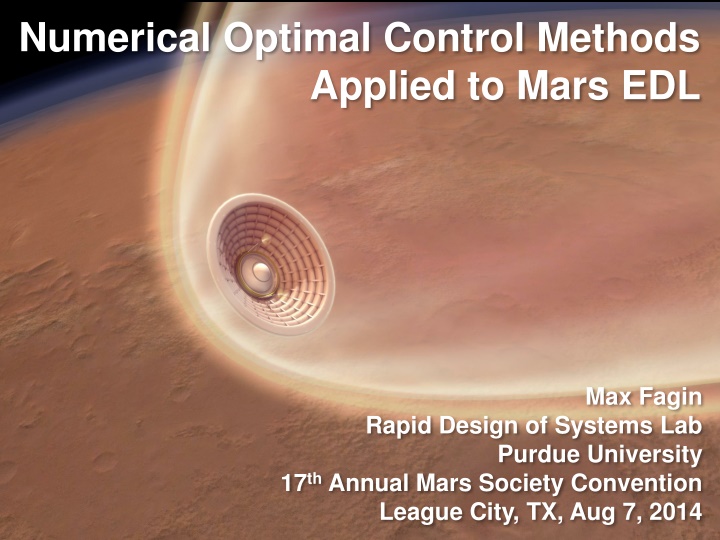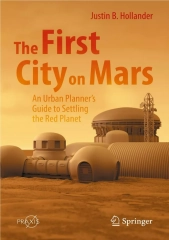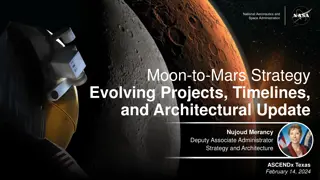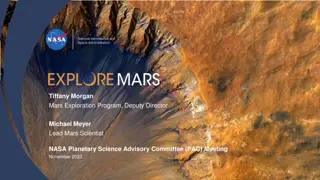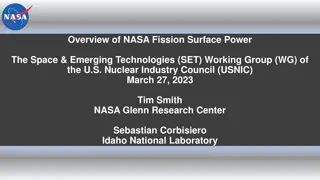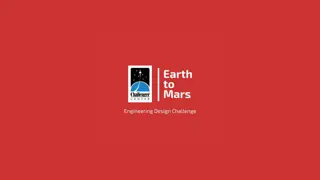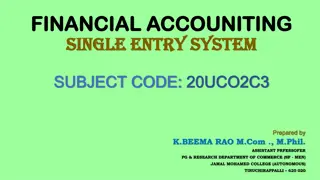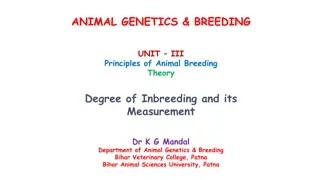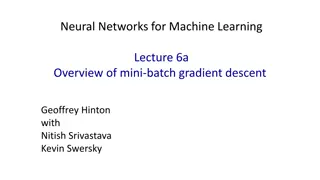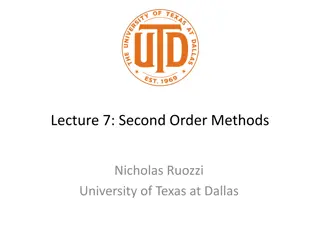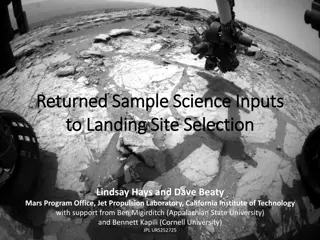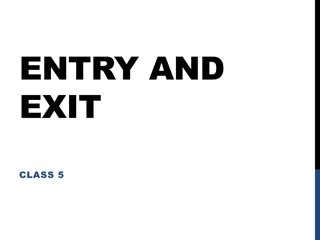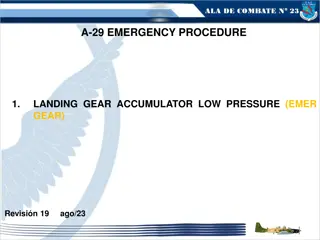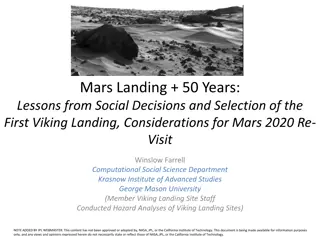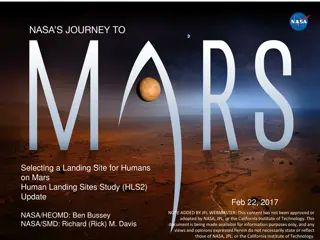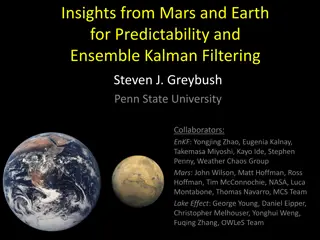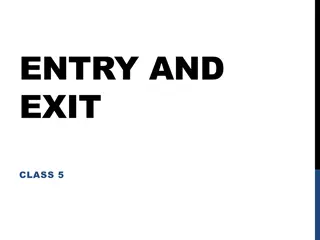Optimal Control Theory for Mars Entry, Descent, and Landing
This content explores the application of optimal control theory to Mars Entry, Descent, and Landing (EDL) procedures, addressing challenges and solutions for precise trajectory planning and implementation. It delves into the historical context and future considerations, emphasizing the importance of analytical solutions in achieving optimal outcomes for spacecraft missions to Mars.
Download Presentation

Please find below an Image/Link to download the presentation.
The content on the website is provided AS IS for your information and personal use only. It may not be sold, licensed, or shared on other websites without obtaining consent from the author.If you encounter any issues during the download, it is possible that the publisher has removed the file from their server.
You are allowed to download the files provided on this website for personal or commercial use, subject to the condition that they are used lawfully. All files are the property of their respective owners.
The content on the website is provided AS IS for your information and personal use only. It may not be sold, licensed, or shared on other websites without obtaining consent from the author.
E N D
Presentation Transcript
Numerical Optimal Control Methods Applied to Mars EDL Max Fagin Rapid Design of Systems Lab Purdue University 17thAnnual Mars Society Convention League City, TX, Aug 7, 2014
Entry Descent and Landing: A Brief History Since the 1960s, 13 spacecraft have made it to the top of Mars atmosphere and 5 of them were destroyed trying to get to the surface.
Entry Descent and Landing: A Brief History Hypersonic Phase: Sub/Trans-sonic Phase: Terminal/Landing:
Tonnes Landed No credible architecture has been put forward that can place a >2 mT payload at high elevations on the surface of Mars. -Braun and Manning, 2007
Entry Descent and Landing: The Near Future INFLATABLES LIFTING BODIES SUPERSONIC RETROPROPULSION RIGID DEPLOYABLES
Entry Descent and Landing: The Near Future These EDL Architectures are hard to implement because they are: 1) Impossible to test in an operational environment without sending to Mars. 2) Physics isn t amenable to analytical modeling (hypersonics, ablation, aeroelastics, shock/plume interactions). Crude approximations required. 3) Have small margins for error and a large design space for trajectory selection. Given an EDL architecture, how do we identify the best trajectory to fly and how do we implement that trajectory in a robust way?
Optimal Control Theory Lets us derive, from first principles and physics, analytical solution to path and trajectory problems which are provably the best solution possible by a given set of criteria. C(s) G(s) R(s) T(s) Classical Control Theory asks: What steering inputs will give the desired trajectory? Optimal Control Theory asks: What is the desired trajectory?
Optimal Control Theory A two slide primer There exists some scalar H (the Hamiltonian), which is a function of the state of the state vector of the system (x) some control parameters (u) and time (t) IF a control history U(t) can be found that satisfies the three conditions: H U= 0 The Euler-Lagrange Theorem : 0 2H U2 The Minimum Principle / Legendre-Clebsch Necessary Condition : The Transversality Condition : THEN it is U(t) must be the control history that produces the minimum value of H.
Optimal Control Theory A two slide primer Find u(t) to minimize H. H can be thermal load, time of flight, g-loading, landing velocity etc. A reader meeting [this subject] for the first time is likely to feel at this stage that a great many things are not completely clear. This is normal. To feel otherwise is either a mark of genius or indication of real trouble Take Away: Optimal control problems are boundary value problems, and can be solved as such.
Advantage: Perturbation Tolerance On all previous EDL methods from Apollo to MSL: Preset Trajectory Classical Method Perturbation Optimal Method
Advantage: Rapid Computation (Example Provided by Thomas Antony, Purdue RDSL) PGS: Prompt Global Strike Deliver a cruise missile to anywhere on the planet in 1 hour Minimum amount of time to target, reroute in flight, subject to constraints (thermal, geographic, g-loads etc.) Trajectories can be computed on board in seconds
Application: Supersonic Retropropulsion The spacecraft has the ability to decelerate propulsively with a thrust coefficient , analogous to a drag of lift coefficient: T CT= (Korzun and Braun, 2009) q A
Application: Supersonic Retropropulsion Convergence on a regular PC in ~10 seconds Fast enough for new trajectories to be computed on the spacecraft in real time during EDL
Application: Lofting Maneuvers w. a Lifting Body (Example provided by Kshitij Mall) Control pitch of a lifting body to optimize different components at different times: Hypersonic Phase: Pitch for thermal limit of spacecraft TPS Sub/Transonic Phase: Pitch for g-load limit of crew Deceleration Phase: Pitch for level flight while bleeding off velocity
Application: Aerocapture with a Dragon (Example provided by Kshitij Mall) Use of directed lift on a Dragon capsule to enable reentry from interplanetary space. For more details, come to Inspiration Mars architecture presentation on Saturday, 5:30.
Conclusions 1) Existing EDL architectures cannot land payloads with mass >1 mT. 2) Proposed human exploration architectures require a mass of 6-28 mT. 3) New EDL methods must be developed, incremental improvements are not sufficient. 4) EDL methods still use classical control based code and techniques. They work, but they are based on Apollo concepts, are not robust, and are not demonstrably the best answer. 5) Optimal control offers several advantages to conventional numerical methods - Real time trajectory computation in seconds - Solve trajectory problems as boundary value problems - Robustness to perturbations - Precision landing site selection Stand by! More to come
Thanks to: Kshitij Mall, Thomas Antony, Michael Grant Questions?
